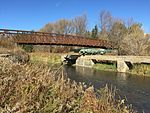Holland Landing
Communities in the Regional Municipality of YorkEast Gwillimbury

Holland Landing is a community in the town of East Gwillimbury, located in the northern part of the Regional Municipality of York, in south-central Ontario, Canada. Its major road is Yonge Street (bypassed by the former Highway 11) and the community has bus service by GO Transit route 68 and York Region Transit route 52 (Monday to Saturday service). The East Gwillimbury GO train station is in the southeast corner of Holland Landing, providing weekday commuter train service. The East Holland River runs through the community and has several marinas for recreational boats. Most of Holland Landing's internal economy is based on the service industry, and some manufacturing.
Excerpt from the Wikipedia article Holland Landing (License: CC BY-SA 3.0, Authors, Images).Holland Landing
Tremoy Road, East Gwillimbury
Geographical coordinates (GPS) Address Nearby Places Show on map
Geographical coordinates (GPS)
| Latitude | Longitude |
|---|---|
| N 44.089444444444 ° | E -79.495 ° |
Address
Holland Landing Airpark
Tremoy Road
L9N 1K9 East Gwillimbury
Ontario, Canada
Open on Google Maps





